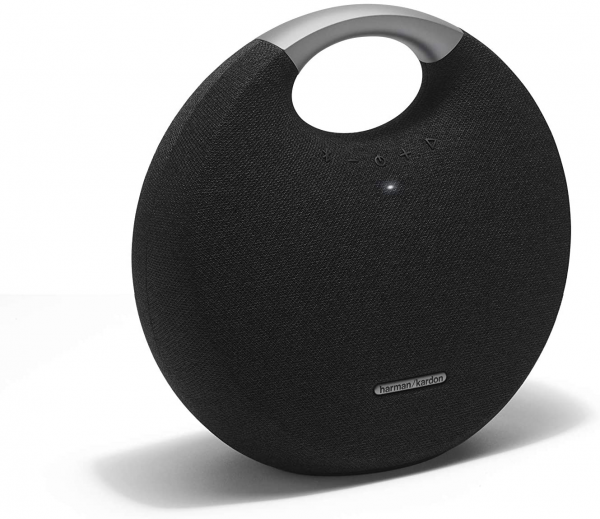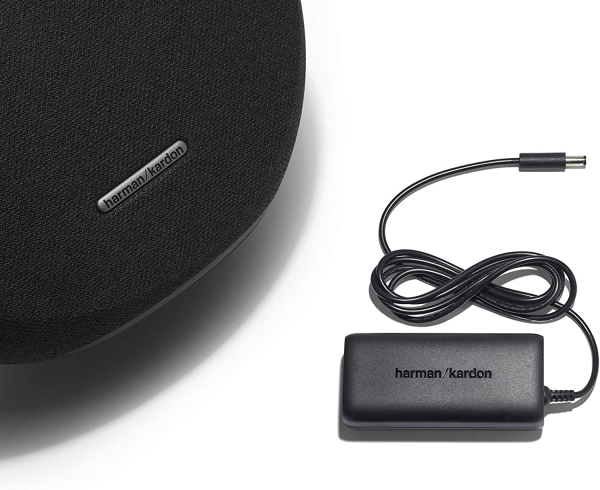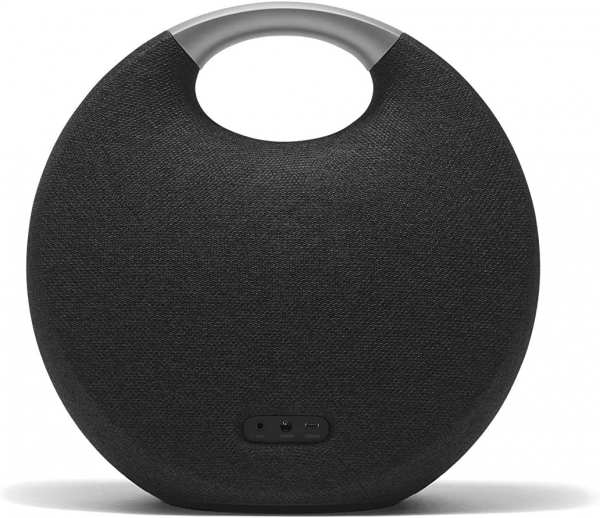Harman/Kardon
Harman / Kardon Onyx Studio 5: a generous portable bass speaker
Aprox. 139€
See specificationsThe emblematic Onyx Studio of Harman / Kardon (launched at € 229) returns to our labs in its fifth iteration. We tried to find out whether the manufacturer had changed things in depth or whether it was content with a simple aesthetic refresh.
Positive points
Extended frequency response, very good voice highlighting.
Deep bass, big impact feeling.
Very correct power reserve.
Manufacturing and finishing in the hair.
Easy to use.
Multipoint connection via Bluetooth (two devices simultaneously).
Bad points
A sound rendering that lacks precision.
HK Connect + compatibility disappears.
Still no key to return to the previous song.
Always worries about latency, and now also wired.
Our review
Ergonomics
The Onyx Studio is one of the iconic models of Harman / Kardon and has always benefited from a very careful design. This is still the case with this new model, and we are delighted. The fifth version breaks with the tilted disc design. Supported for years by a small tripod, the Onyx Studio 5 finally straightens up and shows off its aluminum handle. De facto, it is now much easier to transport it by firmly gripping the handle. The Onyx Studio 5 goes from disc form to handbag format. This change poses no major stability problems. The weight is fairly well balanced and a non-slip surface under the enclosure keeps it in place.
The fabric covering in Scandinavian style now occupies almost the entire enclosure in order to match the aesthetics of the manufacturer's other speakers, notably the Citation range. The control buttons, located on the upper part of the front panel, are almost invisible. We feel that special care has been taken in terms of finishes. Nice job. The whole breathes solidity. However, no particular resistance is promised by the manufacturer. So keep Onyx Studio 5 well away from water points and protect it from falls.
No change on the control side. Almost everything is there (management of playback, calls, listening volume, switching on / off, Bluetooth pairing, going to the next track), but it is still not possible to go back to the start of the track or to the previous track. After 5 versions, you really start to get impatient. Connection and use are very simple: a small LED and a few sound signals guide the user. Some vocal indications in French would not have been too much to help neophytes.
The wireless connection via Bluetooth 4.2 always responds and two devices can be connected to the speaker simultaneously (multipoint). The switch is done automatically in the event of a call, otherwise you must remember to stop the current reading on the source device and then start playback on the second device. Even without an NFC chip, pairing is quick. If you don't need to connect two source devices, you can link two Onyx Studio 5 for stereo broadcasting - just press and hold the Bluetooth pairing button on both speakers. Unfortunately, this model is still exempt from Wi-Fi. In addition, the HK Connect + compatibility disappears, and with it the possibility of connecting several speakers together to broadcast the same content. The application is also no longer in the game, like the microphone for the hands-free kit function. Fortunately, the 3.5 mm mini-jack input is still available (the micro-USB port is only used for firmware updates). Faced with some of its competitors, the Onyx Studio 5 is seriously behind in terms of connection possibilities.
We had great hopes for the Onyx Studio 5 so that it finally respected its promises in terms of autonomy. And we were not disappointed by the 12 h 30 min of use by placing the listening volume at 50% (sufficient to sound a room of 15/20 m² approximately). Beyond that, you quickly lose a few hours on the counter (at 70%, you go down to 8 or even less depending on the content listened to). The speaker is recharged via a detachable proprietary cable with transformer. This cable measures 2.5 m.
Harman / Kardon has unfortunately not made any effort on Bluetooth communication. Due to some concerns encountered with our measurement, we cannot offer you a result consistent with what we have observed in practice. Anyway, the delay in this communication mode is still too high (more than 300 ms), which prevents to follow video content correctly if you do not go through an application that offers latency compensation (like Netflix or YouTube, for example) on a smartphone , or a computer application offering an option to shift the audio track (VLC, among others). With this type of compensation, we manage to follow a video correctly, even during the dialogue phases. Very astonishing thing - and probably due to the calculation of the DSP integrated in the enclosure -, we noted a significant shift in wired connection (more than 175 ms); difficult to follow a video in this case if you cannot compensate for this lag yourself.

Audio
The Onyx Studio is equipped with a 12 cm woofer and a 2.5 cm tweeter powered by an amplification announced at 50 W RMS.
Harman / Kardon was apparently not satisfied with a simple aesthetic refresh. The acoustic design has also been redesigned. The sound signature of the Onyx Studio 5 no longer has much to do with that of the previous model. Finished the good general balance with a slight overweight in the mids, hello the heavy bass and the slight signature in W. It must be admitted that the result, although flattering, remains pleasant and very well controlled. The first part of the spectrum is favored, especially at the level of the low extremes. The extension in this area is very good given the size of the enclosure. The peak around 50 Hz considerably increases the feeling of pressure and impact from the bass (elements like the bass drum and the bass are particularly concerned). On some songs already generous in this area, the abundance of bass extremes coupled with the fact that they drag a little is not always very happy. This creates readability problems (mask effects). This sharper perception of the seat is somewhat detrimental to the definition of low / low mids (valid, for example, for large percussion and bass).
The Onyx Studio 5 remains wiser on the second part of the spectrum, even if there again the precision is not famous. The sound rendering is not very detailed and sometimes becomes bushy on certain songs or certain mixes (many sources present). The reproduction of the midrange is very well balanced, the high-midrange / treble are slightly hollowed out and there is a good extension in the higher frequencies. This signature softens the sound, without giving it a cavernous or muffled appearance. The presence is therefore set back, but the sound reproduction always keeps its slamming side, which is particularly heard on percussion and in particular the snare drum. Drum fans will appreciate it. The voices are not forgotten, far from it. Onyx Studio 5 puts them in the spotlight with a slight highlight, their timbre is respected and they are always intelligible. On the other hand, sibilants have a tendency to pierce a little too often, even at a level of content listening. The Onyx Studio 5 is relatively directive and loses clearly in the high-mid and treble when you shift more than 45 ° from the axis. Better to place it in the direction of the listening point to benefit from the most homogeneous sound possible.
The Onyx Studio 5 has a nice reserve of power, even if we expected a little more given its size. At a reasonable level (50 to 60% of the maximum volume), it is able to sound very correctly a living room of about 20 m² for an evening, for example. The distortion is controlled over the entire spectrum, in any case when the speaker is not pushed to its limits. Beyond 50% of the maximum volume, the sibilants begin to tickle our eardrums, then we gradually lose readability across the spectrum as we increase the volume. There is no point in climbing higher than 70 to 80% of the maximum volume (to be adjusted according to the song listened to).

Conclusion
The Onyx Studio 5 differs from the previous version in many respects (acoustic design and design, sound rendering, functionalities, etc.), but does not revolutionize the recipe. It remains a sedentary transportable speaker pleasant to use, with good sound performance, but it is especially cut for listening to music because of some latency concerns always present (overcome under certain conditions, but still frustrating). We would like to see a next version with full controls, better endurance and above all real versatility. Although they are more expensive, some of its competitors are indeed more capable on these terrains. We think for example of Addon C5.
Specifications

